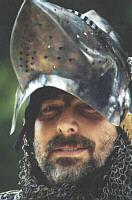 |
, Editor - JManly |
 |
, Executive Editor - JWMA and JManly |
| 12/01 | W.T.A. Beare - Antagonistics: A Comparison of Some Methods of Self-Defence
It is very unfortunate, in my view, that difficulties arose in connection with the promised display of Japanese wrestling at the Alhambra, and that no public performance ever took place; for it is always interesting to observe the methods of personal defence and attack in general use by other nationalities and compare them with our own. |
| 11/01 | C. Phillipps-Wolley - Singlestick
Singlesticks is to the sabre what the foil is to the rapier, and while foil-play is the science of using the point only, sabre-play is the science of using a weapon, which has both point and edge, to the best advantage. In almost every treatise on fencing my subject has been treated with scant ceremony. |
| 11/01 | Tony Wolf - Inside Two Georgian Schools of Arms
In 1785 fencing master Harry Angelo left his father Domenico's School of Arms in Carlisle House and established his own academy at the Opera House in London's fashionable Haymarket district. Here he conducted lessons, both in his father's traditional style of foil fencing, and also in single-stick play, for which he had a particular fondness. |
| 10/01 | Roger Robson - Cumberland and Westmorland Wrestling Fashions 1815-1999
Before 1860 Cumberland and Westmorland wrestlers simply stripped off to their shirts, breeches and stockings before competing. The neat fit of the garments made them ideal for wrestling as they did not impede trips such as the hank and the outside stroke, and they would not obscure falls for the judges. |
| 10/01 | The Japan Times - Japanese Wrestling
Misfortune, says the Times, seems to follow Mr. Barton Wright in his efforts to place the Japanese system of wrestling before the British public. Last year he gave at the St. James' Hall an exhibition which attracted much notice, but a special display before the Prince of Wales at the Gallery Club fell through because Mr. Barton Wright had a bicycle accident. |
| 09/01 | Mark S. Hewitt - Professional Wrestling: Frank Gotch in the Klondike
During the summer of 1901, Frank Gotch wrestled in the Klondike. As Gotch went on to become one of America’s most famous professional wrestlers, it is surprising that this portion of his career has not received greater scrutiny, and this article is an effort to correct that omission. |
| 09/01 | R.G. Allanson-Winn - The Quarter-staff
According to Chambers's "Encyclopaedia," the quarter-staff was formerly a favourite weapon with the English for hand-to-hand encounters. It was "a stout pole of heavy wood, about six and a half feet long, shod with iron at both ends. It was grasped in the middle by one hand, and the attack was made by giving it a rapid circular motion, which brought the loaded ends on the opponent at unexpected points." |
| 09/01 | Thomas A. McCarthy - "Quarter-staff: A Practical Manual"
The object of the author in compiling this little work is to fill an evident gap, there not being any special treatise in existence upon the once-popular art of Quarter-staff. |
| 08/01 | Tony Wolf - A Grand Assault-at-Arms" Tournaments and Combative Exhibitions in Victorian England
The phrase "Assault at (or 'of') Arms" was coined in the early 19th century to describe displays of skill-at-arms performed as public entertainment. Many of these events combined competition with showmanship; some were strictly competitive and others pure ballyhoo. |
| 08/01 | Keith Myers - The Punching Bags of Pugilism
Striking a bag of some sort has long been associated with boxing. When asked to think of a boxing gym today, most people will picture a warehouse-like space with a roped boxing ring in the center and an array of heavy bags and speed bags hanging along the walls. |
| 07/01 | Glynn A. Leyshon - Wrestling in Canada I, 1776-1914: The Pioneers
Since Canada was settled by people with a sports and a wrestling tradition, it would seem logical to assume that when they established themselves finally in Canada, they would maintain these pastimes. Despite the inheritance, there is only evidence of sporadic involvement in sport generally throughout pioneer Canada. |
| 07/01 | Glynn A. Leyshon - Wrestling in Canada II, 1860-1914
By the mid-nineteenth century, professional wrestling was a booming spectator sport in Europe, and it wasn't far behind in North America. For example, the Scottish wrestler and strongman Donald Dinnie began a world tour in 1877 that included a visit to Canada. |
| 06/01 | Mark Twain - How Bismark Fought
In addition to the corps laws, there are some corps usages which have the force of laws. Perhaps the president of a corps notices that one of the membership who is no longer an exempt--that is a freshman-- has remained a sophomore some little time without volunteering to fight; some day, the president, instead of calling for volunteers, will appoint this sophomore to measure swords with a student of another corps; he is free to decline--everybody says so--there is no compulsion. |
| 06/01 | Robert W. Smith - French Boxing (La Boxe Française)
The poet Gautier, who lived during the zenith of French boxing's popularity, has stated the case fairly. French boxing, although no longer popular, is a total sport. It requires some qualities from its learners but gives many more. |
| 05/01 | Mark Twain - A Sport that Sometimes Kills
The third duel was brief and bloody. The surgeon stopped it when he saw that one of the men had received such bad wounds that he could not fight longer without endangering his life. |
| 05/01 | Graham Noble - The Life and Death of the Terrible Turk
The golden years of professional wrestling, around the beginning of the twentieth century: the era of Hackenschmidt, his sensational arrival in London, and his eclipse by Frank Gotch a few years later; of Pons, Zbyszko, Padoubny; of the great Indian wrestlers: Ghulam, Imam Bux, Gama; and the Turks: Cour-Derelli, Ahmed Madrali, Youssuf Ishmaelo - names which can still stir the true chronicler's blood. |
| 04/01 | Elliott J. Gorn - Gouge and Bite, Pull Hair and Scratch
"I would advise you when You do fight Not to act like Tygers and Bears as these Virginians do - Biting one anothers Lips and Noses off, and gowging one another - that is, thrusting out one anothers Eyes, and kicking one another on the Cods, to the Great damage of many a Poor Woman." |
| 04/01 | Mark Twain - At the Student's Duelling Ground
One day in the interest of science my agent obtained permission to bring me to the students' dueling-place. We crossed the river and drove up the bank a few hundred yards, then turned to the left, entered a narrow alley, followed it a hundred yards and arrived at a two-story public house; we were acquainted with its outside aspect, for it was visible from the hotel. |
| 03/01 | Graham Noble - An Introduction to E. W. Barton-Wright (1860-1951) and the Eclectic Art of Bartitsu
Richard Gordon Smith, an Englishman living in Japan at the beginning of the twentieth century, made a note in his diary about a demonstration of martial arts he had witnessed: Saw an interesting assault of arms today given by Mr. Uchida, Chief of the Prefectural Police... |
| 03/01 | unnamed; illustrated by R. Noel Pocock - The Bartitsu Tournament 1902
"What is Bartitsu?" asked the Person-who-draws-the-pictures, as we walked down Regent Street. "Bartitsu and Jujitsu," I began, with a refined Japanese accent. |
You are welcome to contact the editor, Tony Wolf with comments on the journal or to submit via email, "Letter to the Editor". Letters to the editor will be published in the above listing in a similar fashion as articles submitted.
- For an excellent printed resource and more information on a subscription, visit Western Martial Arts Illustrated.
- You can find more information on medieval fighting arts at the Academy of European Medieval Martial Arts website or to view an extensive online library of medieval fighting arts treatises visit the AEMMA Online Library.
, Editor - JManly
Tony is a professional fight director and martial arts/stage combat tutor. Since 1978 he has traversed a wide range of Asian, Polynesian and European martial arts, with a particular interest in both European "folk styles" and the combatives of the late 1800s. He was a pioneer of padded-attacker self-defence training in his home country of New Zealand and serves as an advisor for several international martial arts and stage combat organisations.
Tony's fight direction and action sequences have been featured in over one hundred and seventy feature film, television, theatre, opera and ballet productions. Between 1998-2000 he served as the Fighting Styles Designer for Peter Jackson's Lord of the Rings movie trilogy and in 2002 he toured Japan with the Washington Opera Company's production of Otello starring Placido Domingo. Tony has taught, directed and performed throughout New Zealand, as well as in Australia, the USA, England, Ireland, Canada and Japan. He lives in Wellington, New Zealand with his son, Josh., Executive Editor - JWMA and JManly
David is the Founder and President of the Academy of European Medieval Martial Arts (AEMMA), an organization dedicated to the resurrection and formalization of medieval martial arts training systems. He received training in Milan, Italy employing steel weapons in longsword techniques and has participated in various organizations dedicated to studying the Middle Ages. His background and experience having fired his desire to pursue a formal medieval martial arts training program, he founded AEMMA in mid-1998. He is a member of the advisory board of the Swordplay Symposium International (SSI), an interdisciplinary colloquium of historical fencing specialists dedicated to promoting and advancing the study of Western swordsmanship, and participating board member of the Association for Historical Fencing (AHF). David received his appointment of free scholler in Oct, 2000, and is the provost of the Academy as of May 1, 2005.
He is also the Vice President of the Royal Heraldry Society of Canada.